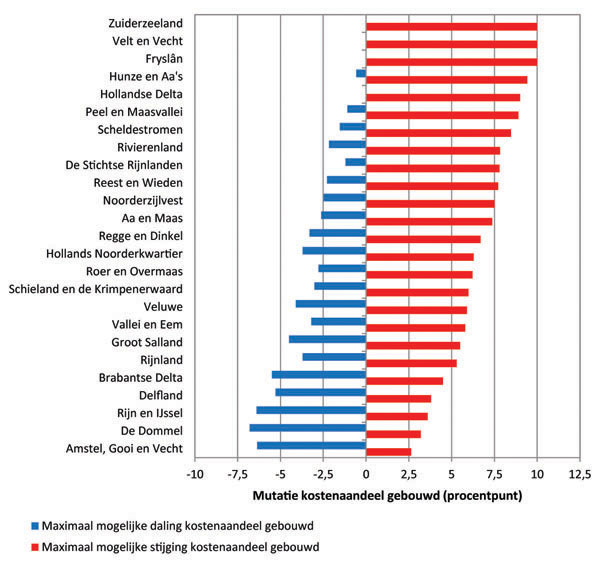Huiseigenaren gaan meer betalen voor droge voeten
De Unie van Waterschappen stelt voor om het belastingsysteem van waterschappen te wijzigen. De plannen moeten per 1 januari 2013 ingaan. De lasten zullen dan nog meer dan nu worden verhaald op huiseigenaren. Grondeigenaren (boeren) gaan er op vooruit. Dat blijkt uit een analyse door COELO in het Weekblad Fiscaal Recht. COELO (Centrum voor onderzoek van de economie van de lagere overheden) is een onderzoeksinstituut verbonden aan de Rijksuniversiteit Groningen.
De 26 waterschappen die Nederland rijk is zorgen voor droge voeten en onderhouden dijken. De kosten die zij hiervoor maken verdelen zij over huishoudens, eigenaren van gebouwen (vooral huiseigenaren) en eigenaren van grond (vooral boeren). Wie meer profiteert van het waterschapswerk hoort volgens de wet ook een groter deel van de kosten te betalen. Eigenaren van gebouwen betalen nu circa de helft van de kosten.
De Unie van Waterschappen heeft voorstellen gepubliceerd om op een nieuwe manier te bepalen wie welk deel van de kosten betaalt. Uit onderzoek van COELO blijkt dat eigenaren van gebouwen hierdoor een groter deel van de kosten gaan betalen dan nu het geval is.
Wie betaalt wat?
Waterschappen kennen aparte heffingen voor huishoudens, eigenaren van gebouwen en eigenaren van grond. Een huishouden met een eigen woning betaalt dus twee verschillende waterschapsheffingen; wie daarbij nog grond bezit betaalt drie heffingen.
Volgens de huidige wetgeving hangt het deel van de kosten dat huishoudens betalen af van de bevolkingsdichtheid in het waterschap. De rest van de kosten wordt verdeeld tussen huiseigenaren (gebouwd) en eigenaren van grond (ongebouwd en natuur); dit op basis van de economische waarde van gebouwen en grond.
De Unie van Waterschappen stelt voor om voor eigenaren van grond voortaan andere uitgangspunten te gaan hanteren dan voor eigenaren van gebouwen. Het kostenaandeel voor eigenaren van grond wordt afhankelijk van het aantal hectaren grond per 1000 inwoners. Eigenaren van gebouwen betalen de overblijvende kosten. Het kostenaandeel dat huishoudens betalen verandert niet.
Bestaande problemen niet opgelost
De aanpassing is volgens de Unie van Waterschappen nodig omdat het huidige belastingsysteem een weeffout zou bevatten. In sommige waterschappen zou het tarief voor ongebouwd (vooral agrariërs) nu te hoog zijn. Maar COELO laat zien dat juist in deze waterschappen het kostenaandeel van agrariërs slechts beperkt daalt als de plannen doorgaan.
Gevolgen huiseigenaren
Als tweede reden wordt genoemd dat waterschappen voortaan meebetalen aan het Hoogwaterbeschermingsprogramma van de rijksoverheid. Dit programma regelt de versterking van de belangrijkste dijken (vooral rondom de grote rivieren en langs de Noordzee). De extra kosten voor de waterschappen moeten op een rechtvaardige manier worden verdeeld. Met het huidige systeem zou dit niet mogelijk zijn.
De voorstellen leiden echter tot veranderingen die moeilijk zijn uit te leggen. Zo gaan eigenaren van gebouwen een groter deel van de kosten betalen naarmate de bevolkingsdichtheid kleiner is en omgekeerd. Dat is niet logisch. Als de bevolkingsdichtheid kleiner is, zijn er minder woningen en is dus ook het belang van huiseigenaren bij het waterschapswerk kleiner. Toch betalen zij meer. Dat is in strijd met het principe dat betaling afhangt van belang.

Bestuurlijke vrijheid
De voorstellen geven waterschapsbestuurders meer vrijheid om de kostenaandelen van de verschillende groepen belastingbetalers vast te stellen. Nu zijn die kostenaandelen grotendeels een uitkomst van een rekenkundige exercitie. De Unie wil waterschappen kostenaandelen laten kiezen binnen voor hen geldende bandbreedtes.
De figuur laat zien dat eigenaren van gebouwen in alle waterschappen zwaarder kunnen worden belast. In drie waterschappen (Zuiderzeeland, Velt en Vecht en Fryslân) kan het bestuur hun kostenaandeel tot 10 procentpunt verhogen. In waterschap Amstel, Gooi en Vecht, onderin de figuur, is een stijging van het kostenaandeel van huiseigenaren mogelijk met 2,6 procentpunt, maar ook een daling met 6,4 procent.
Politiek
De waterschapsbestuurders worden nu nog gekozen via rechtstreekse verkiezingen. Dit gaat mogelijk veranderen. Het kabinet wil dat de gemeenteraden de waterschapsbesturen gaan kiezen. Dit kan betekenen dat de besturen een sterker politiek karakter krijgen en dat politieke voorkeuren gaan bepalen wie welk deel van de kosten betaalt.
Noot voor de pers
Meer informatie: dr. Corine Hoeben, tel. 050-3633766, e-mail coelo rug.nl of www.coelo.nl.
C. Hoeben, 2011 Voorgestelde wijzigingen waterschapsbelastingen vergroten weeffout, Weekblad Fiscaal Recht, no. 6931
Meer nieuws
-
09 december 2025
Zijn robots de oplossing?
-
10 november 2025
Decentralisatie van de jeugdzorg
